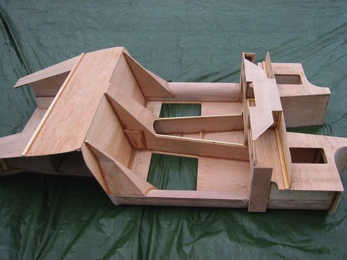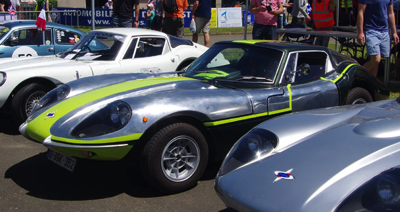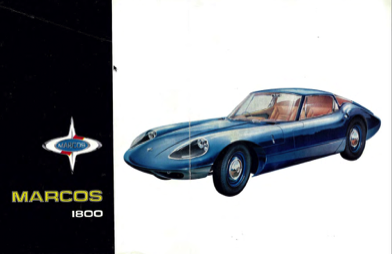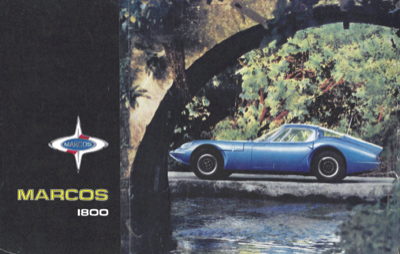Marcos GT 1800

Marcos 1800 Volvo's at Prescot Revival 2014, including Chassis number 1 (White Car), as seen at the Racing Car Show in 1965. (©️ Roger Young)



The aluminium plugs, used to make the body moolds, have been put together to make the 'only metal bodied' car. seen here at the Great British Wlecome, St. Saturnin, Lemans


In 1963, Denis and Peter Adams took charge of the design work at Marcos, the former concentrating on body design and the latter on the mechanical side, for an entirely new car, which made its appearance at the 1964 Racing Car Show. This was the Volvo-engined Marcos 1800, which stole the show, and even though it was very much a prototype and only just finished in time, it received acclaim from everyone for its styling and general conception as well as its finish and detail work.
The early part of 1964 was spent in getting the Show car into a production form and a year later the 1800 was well under way, with two cars being completed each week and provision for five a week being on the way. Two cars a week may sound very low volume, but the Marcos 1800 was a hand-made car in the true sense of the words.
The chassis is made up of a series of marine-ply monocoque units cemented to a marine-ply base board, the thickness varying from 5-ply to an eighth of an inch, depending on the work it is doing. With modern adhesives plywood can be cemented together to give a joint at least as strong as welding sheet steel, if not stronger, and by the time the central backbone tunnel, the long boxes under the doors, the bulkheads fore and aft, the foot wells and the engine bay are all attached to the main floor the result is an immensely strong but extremely light structure. All the sections are cut and fitted on steel jigs, these being removed once the cement has set. The differential unit is mounted on steel brackets bolted to the rear of the central box member, and a space-frame of small square-section tubing bolts to the front bulkheads, either side of the engine bay and this space-frame carries the front suspension and steering, as well as things like the radiator and hinges for the one-piece bonnet. Before any mechanical components are fitted the completed monocoque, or multi-coque as it should be called, is inverted and given a coating of fibre-glass, not as protection from the elements, for marine-ply can cope with them, but to prevent damage by flying stones and gravel.
While all this is going on in the wood-working shop amidst the sound of buzz-saws and the smell of sawdust, the bodyshell is made in another building. The body is made from uncoloured fibre-glass on a very accurate mould and is in one piece from tail to bulkhead in front of the windscreen, but less doors and boot-lid, naturally. As the wooden chassis is a self-contained structure needing no further bracing the fibre-glass body is not stressed in any way, which helps enormously with the detail fitting of doors, windows and windscreen, etc. This fibre-glass shell is designed to be a "spring-fit" around the wooden chassis and once sprung into place it is bonded to the wood at all points, thus making a very leak-proof unit. The windscreen and side windows are of laminated glass and the rear window is Perspex, while door window surrounds are of aluminium. The rake of the windscreen is very noticeable and a lot of thought has gone into this, the glass being made specially for Marcos by Tudor. At first glance it appears to be a single curvature, but that would cause distortion and as distortion is non-existent from the driving seat, it is obvious that the shape is all-important. It consists of two flat sections, in front of the seats, a curved centre section and curved ends, and must be considered a triumph of glass manufacture by Tudor, to form the whole thing in one piece. Because the bodyshell is not taking any stresses it is possible to mount the windscreen on a jelly-like rubber compound that does not set hard and an aluminium surround seals the joint. Doors, boot-lid and one-piece bonnet are all of fibre-glass. A great deal of attention has been paid to the interior trim, the lining, the seats, the carpeting and so on all being to a very high standard, while even the boot is lined with a quilted material. With such a superb-looking body-shape it is nice to see similar trouble being taken over the detail finishing of the body both outside and inside, and the cellulose process on the bodyshell is done very carefully, a high degree of finish being achieved.
Front suspension is by unequal-length wishbones and coil-spring/damper units, with rack-and-pinion steering, and is a complete assembly "bought out" and similar to that used by Triumph. The rear suspension is Marcos manufactured and could be described as floating-de Dion, each wheel being carried on a forward facing fabricated arm, pivoted at the rear of the chassis. These two arms are joined by a tube with universal moving ends, both as regards rotation and changes in length. Fixed-length drive shafts, universally jointed at both ends, are used from the chassis mounted differential unit. Disc front brakes are used and inboard mounted drums at the rear, while rear suspension is by coil spring-damper units.
Wanting to build a car in the 2-litre class, Marsh studied the world's engines and settled on the 1800 Volvo unit, the Swedish manufacturers and agents being quite willing to supply him direct. Not only is the 4-cylinder o.h.v. Volvo engine known for its ruggedness, but it will obviously stand a lot of development. The Marcos 1800 uses a perfectly standard Volvo engine and gearbox, but Marcos inlet manifolds and twin Zenith-Stromberg carburetters are used and a Marcos exhaust system is fitted, these giving a slight improvement over the standard items, but at the same time preserving the inherent ruggedness and reliability of the Swedish engine. It is intentional to keep to standard production units, for the Marcos is a production road car rather than a competition coupé, but for anyone interested in more performance there is an engine development department at Bradford-on-Avon producing tuning equipment. Already there is a full 2-litre engine available, using larger bore Mahle pistons, three stages of camshaft development, two double-choke Weber carburetter layout, close-ratio gearbox and so on, and tuning development continues for Marcos intend to develop-through-racing, even though the 1800 is a road car rather than a racing car.
Having seen how the Marcos 1800 is built, the next thing was to find out how it performed, so a production model was taken away for three days and 550 miles. Naturally, a small-production firm like Marcos cannot keep a special Press Road Test car like the big manufacturers, so I was loaned a car that had done some 1,500 miles in the hands of Mrs. Cavendish. The seats in the Marcos 1800 set a new standard in comfort and support, the driving position being on modern Grand Prix lines, of lying back at full stretch. With the seat being built into the chassis structure, variation in driver size is accommodated by mounting all three pedals on a cradle that travels fore and aft some 4 inches, operated by a quick-start screw thread, from a knob on the instrument panel. The disposition of the pedals relative to each other is perfect for all movements and especially heel and toe downward gearchanges, and as the movable carrier has the master cylinders mounted on it the pedal layout is the same in all positions, the levers hanging down from the carrier. The 14-inch wood-rimmed steering wheel is a two-spoke affair made of stainless steel and the spokes drop slightly from the horizontal to ensure they don't mask the speedo and rev-counter. Again, in G.P. fashion, the wheel is nearly vertical and you soon get into the way of pretending to be Jim Clark! Considering that this coupé is only 41½ inches high and, as a friend said "You have to get down on your hands and knees to get into it," once you are in the visibility is not only good, it is faultless and in more than 500 miles of varied motoring, from Motorway to London traffic, I did not find any "blind spots." The only limitation was in reversing down a drive, but then the easiest way was to "do a van-driver" and open the door and look round the side of the car. Before driving the car I fully expected to suffer from lack of vision and was prepared to accept a letter-box like view, but found it the complete opposite. Between the seats is the centre box section of the chassis and at the front of this is the main instrument and switch panel, including fuel gauge, oil pressure, and water temperature, as well as radio and heater controls. On top of the box is the gear lever for the 4-speed Volvo box and the over-drive switch which produces a fifth gear, after you have changed into fourth gear. A steering column stalk on the left selects side, head or dipped lamps, once a master switch has been pushed down, and a pull towards you flashes main beams. A right-hand stalk operates winkers, the horn button being in the centre of the steering wheel. On the right is a rather ineffectual pull-out handbrake that would not pass an M.O.T. test.
The Volvo engine has never been a particularly quiet unit, and even though Marcos have lined the engine bay with radio screening material, and the cockpit is well finished in carpeting, a lot of noise comes into the car under heavy throttle work, while the exhaust noise is far too loud for this type of car. This high noise level is a pity, for in a stark competition coupé it would not matter, but in such an elegant and well finished car it seems out of place. Also adding to this high noise level was the fact that the Pirelli Cinturato tyres were better for road-holding at 24 lb./sq. in. than the recommended 18 lb./sq. in. The steering has the incredibly good turning circle of 26 ft. 6 in., achieved by 2¾ turns from lock to lock, while on the open road, and even on fast roundabouts the steering is so high-geared that only wrist-movement is required, which blends nicely into the "full-stretch" driving position. The handling characteristics are an unbelievable degree of neutral-steer, in fact, too much neutral for my liking and a little understeer tendency would make it even better. This neutral character tended to make the car weave slightly at 100 m.p.h. and the rather firm suspension accentuates it. The cornering power of the car is incredibly high and I did not find a convenient corner or occasion to reach the limit, so took it to a test-track with a dry tarmac circle. On a fixed radius in 2nd gear I achieved "G" forces that became uncomfortable long before the limit of tyre adhesion was reached, but final oversteer came in very gradually. With such a low centre of gravity roll was non-existent.
The great charm of the Marcos 1800, apart from its looks, is its flexibility, brought about by an engine with excellent torque at 3,500 r.p.m., and sufficient acceleration in 5th gear at these revs, to pass things on the open road and go on up to 5,000 r.p.m. This is brought about by the remarkably low weight of 14 Cwt. 3 qtr. 21 lb. (1,673 lb.) in complete road-going trim. On main road running the car is very fast about the place using only the overdrive switch, for it will run up to over 90 m.p.h. in direct-top, and the change into overdrive, which is 0.8 to 1, is so simple and smooth, especially if you treat the switch as a gear lever, and make clutch-less changes on the throttle pedal, that you tend to use it all the time. With a 3.9 to 1 final drive and the 0.8 to 1 overdrive, the car bowls along at 21½ m.p.h. per 1000 r.p.m. If, you want to really hurry you use the gearbox and then it becomes one of those cars that you "point and squirt," rather than consciously steer and direct. A standing-start ¼-mile in 16.9 seconds speaks for itself, for this untuned 110 b.h.p., 1,800 c.c. car. There are lots of cars that are good fun to drive fast, but tedious and fussy to drive slowly, and vice-versa, but the Marcos suited any mood and had pleasant characteristics whether pottering or "playing bears." Unfortunately the engine in the test car had a horrid flat-spot in the carburation at 5,000 r.p.m. and there was a pause before it went on up to 6,500 r.p.m. and this kept the top speed down to about 107/110 m.p.h. (a speedo. reading of 118 m.p.h.) for the gearing was such that 5,000 r.p.m. in overdrive was just getting into its stride. If the carburation could be altered to give clean pulling at these revs, it would undoubtedly go on up to 110-115 m.p.h. This is with the standard power unit giving 110 b.h.p.; the 2-litre highly tuned 155 b.h.p. unit would really make the Marcos a fast car, but would inevitably lose flexibility which is one of the great charms of the standard car. On the open road it is happiest at 85/90 m.p.h., these speeds being a natural all-day cruising gait, and at night the four headlamps permit 80 m.p.h. cruising on known roads, the outer pair staying on for dipped beam.
The exact mileage done in the car could not be logged as the Smith's speedo. broke after 406 miles, and fuel consumption could not be checked, but it would obviously depend on the manner of driving, for it could be cruised gently-along in 5th gear at 2,000 r.p.m. or really rushed along at 5,600-6,000 r.p.m. using the gearbox. There was no reserve tap so the rather inaccurate Smith's contents gauge had to be used, and a bare 200 miles could be done before panic set in and I could no longer stand the sight of the gauge needle sitting resolutely on "Empty." While the handling and ride was good enough for main roads, it was very choppy on undulating roads and came out very badly on ride-assessment over our local test strip, but though hard, the ride was not unpleasant or uncontrollable, but it was very much "sports-car." A reduction of tyre pressures improved things, but at the cost of not so good handling. Another criticism was a "jump" in the steering when a front wheel hit a certain type of bump. While this did not alter the line of the car it gave a disconcerting kick to the steering wheel, a fault to be found in the Triumph Vitesse, I am told, which uses the same front suspension and steering.
During the three days' continual use there was a growing tendency for the throttle not to shut properly, the tick-over progressively creeping up from 600 r.p.m. to 2,000 r.p.m. An investigation showed that excessive wear was taking place on the Zenith linkage on the front throttle spindle, but a "tweak" with a pair of pliers cured this. Alter having given the car a good thrashing about the place; using it in all types of going, given numerous friends rides in it, all of whom gave the seating 100% praise, for it really does set a new standard, I was belting happily across Salisbury Plain on my way back to Bradford-on-Avon, when it all died away. I had just been thinking how well the car had behaved and that the only thing that had gone wrong was the speedometer, and that compared with some manufacturers who produce special Press Road Test cars, Marcos had shown up well. Fortunately the trouble was not serious, though it was unnecessary, for it was an h.t. wire that had chafed through on a Jubilee clip.
To sum up, I would say that the Marcos 1800 is definitely my type of car, the noise level is too high and at first glance the price of £2,283 makes you stagger back, though it can be supplied in kit form for £1,865, but Marcos are trying very hard to produce a car to very high standards both of design and finish and in this they are succeeding. When first seen at the Racing Car Show it looked like a car with a future, and after this brief acquaintance I feel it is on the way to a good future. Nothing is perfect and the Marcos 1800 cannot pretend to be, but I do feel this is a very good attempt to produce not only an interesting car but a good one as well. D. S. J.
Marcos 1800 GT Coupé 2-seater
Engine : 4-cylinder pushrod o.h.v. 84.14 x 80 mm. (1,783 c.c.).
Gearbox : 4-speed with Laycock overdrive on 4th gear.
Suspension : i.f.s by double wishbones and coil springs. i.r.s. by leading links, transverse stabilising tube and coil springs.
Chassis : Marine-ply wooden monocoque construction.
Body : Fibre-glass bonded to chassis unit.
Weight (as tested) : 14 cwt. 3 qtr. 21 lb.
Dimensions :
Wheelbase : 89 in.
Track : 49 in. front, 49½ in. rear.
Height : 41½ in.
Overall length : 159 in.
Turning circle : 26 ft. 6 in.
Price : £1,885 plus £398 2s. 5d. Purchase Tax—total £2,283 2s. 5d.
Makers : Marcos Cars Ltd., Factory and Export, Greenland Mills, Bradford-on-Avon, Wiltshire, England.


